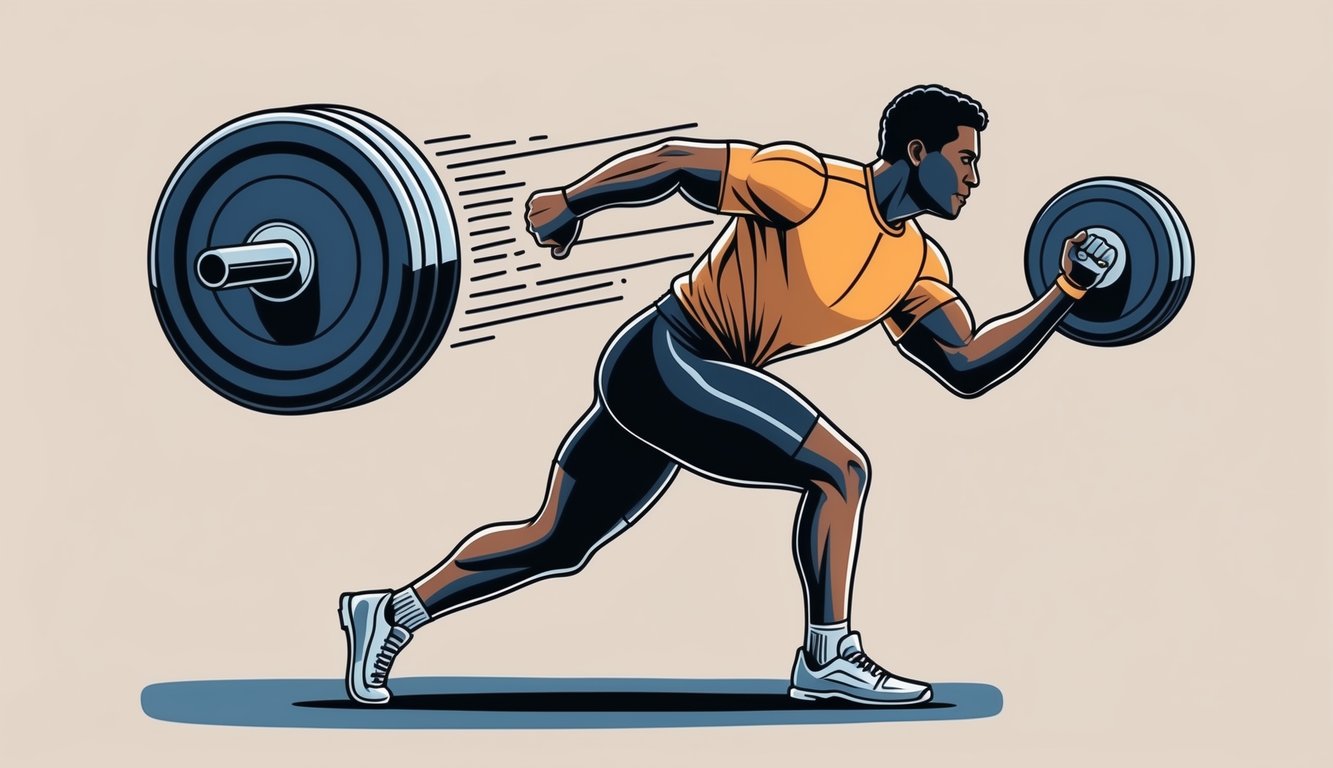The Standing Power Throw is a vital component of the Army Combat Fitness Test (ACFT), designed to assess explosive power and coordination.
By mastering this event, you can significantly enhance your overall ACFT score and improve your physical readiness for military responsibilities.
To elevate your Standing Power Throw performance, concentrate on strengthening your hip drive, upper body, and mastering proper technique.
Enhancing your Standing Power Throw necessitates a mix of targeted exercises and consistent practice.
Integrate explosive movements like box jumps and medicine ball throws into your training regimen to develop power.
Maintain attention to your form, ensuring that you engage your entire body in a smooth motion while throwing.
Remember to push through your hips and extend your arms fully to achieve maximum distance.
Don’t underestimate the role of strength training in your journey to improve your Standing Power Throw.
Incorporate exercises such as deadlifts, squats, and shoulder presses to build the essential muscle groups.
Regular practice with a medicine ball or shot put will help you fine-tune your technique and establish muscle memory for the actual test.
Key Takeaways
- Prioritize hip drive and full-body coordination for optimal throw distance
- Include explosive exercises and strength training in your routine
- Practice consistently with correct form to enhance technique and muscle memory
Understanding the Standing Power Throw
The Standing Power Throw (SPT) is a key part of the Army Combat Fitness Test, which evaluates explosive power.
Excelling in this event requires proper training and technique to maximize power and distance.
What Is the Standing Power Throw?
The Standing Power Throw involves tossing a 10-pound medicine ball backwards over your head for maximum distance.
You start in a standing position, facing away from the target.
The objective is to generate maximum force using your legs, core, and upper body to propel the ball.
You have two attempts, with your best throw being counted toward your score.
The distance is measured from the starting line to the first point where the ball touches the ground.
Importance in the ACFT
The SPT evaluates your potential to generate explosive power swiftly.
This ability is crucial for military tasks such as lifting heavy equipment, overcoming obstacles, or moving quickly in combat situations.
Your performance in this event contributes to your overall ACFT score.
A strong performance can enhance your total score and reflect your preparedness for demanding military tasks.
Key Components of a Successful SPT
To excel in the Standing Power Throw, pay attention to these essential elements:
- Leg drive: Create force from the ground up by explosively extending your legs.
- Hip hinge: Bend at the hips to engage your posterior chain muscles.
- Core engagement: Stabilize your trunk to effectively transfer power.
- Arm extension: Forcefully extend your arms to release the ball at the best angle.
Practice the proper sequence of these movements to maximize your throw’s distance.
Start with a slight countermovement, then explode upward and backward.
Release the medicine ball when your arms are fully extended overhead.
Preparation and Form
Adequate preparation and form are vital for maximizing your Standing Power Throw performance.
Focus on key aspects to enhance your technique and power output.
Proper Starting Position
Begin with your feet shoulder-width apart, toes slightly turned out.
Hold the medicine ball close to your chest with both hands.
Bend your knees and hips slightly, keeping your back straight and core engaged.
This athletic stance lays a strong foundation for your throw.
Evenly distribute your weight between both feet.
Practice maintaining balance as you shift your weight slightly backward.
Remain relaxed in your shoulders and keep your head up, focusing on a point directly ahead.
Mastering the Throw Technique
Initiate the throw by dipping down, bending your knees and hips.
As you explosively extend upward, push through your legs and hips.
Bring the ball overhead, keeping your arms straight.
Release the ball at the peak of your throw, just as your body reaches complete extension.
Follow through with your arms, continuing the motion after release.
Coordinate your arm and leg movements to ensure maximum power transfer.
Focus on timing your release to achieve the best angle for distance.
Safety Tips
Always warm up before attempting the Standing Power Throw.
Start with light dynamic stretches that focus on your shoulders, back, and legs.
Select a medicine ball that suits your strength level.
Begin with a lighter ball to master your form before moving to heavier weights.
Ensure enough space behind you for the backswing and in front for the throw.
Clear the area of any obstacles or bystanders.
Keep your back straight during the throw.
Maintain a tight core to protect your spine.
If you feel any pain, stop immediately and consult a medical professional.
Practice with a partner who can provide feedback on your form and technique to help identify and correct issues in your throw.
Physical Conditioning for SPT
Enhancing your Standing Power Throw needs a comprehensive approach to physical conditioning.
Focus on developing strength in key muscle groups, enhancing explosive power, and improving overall body coordination.
Developing Core and Leg Strength
Begin with foundational exercises that build a strong base for your SPT performance.
Squats are essential for leg strength—aim for 3-4 sets of 8-12 reps, gradually increasing weight as you progress.
Deadlifts target your posterior chain, vital for the throwing motion.
Perform 3 sets of 6-8 reps, prioritizing proper form.
Core exercises, such as planks and Russian twists, help fortify your midsection.
Aim for 3 sets of 30-second planks and 3 sets of 15-20 Russian twists.
For targeted leg workouts, include lunges and step-ups, performing 3 sets of 10-12 reps per leg for each exercise.
Plyometric Training for Explosive Power
Plyometrics enhance your ability to generate force rapidly.
Box jumps are excellent for developing lower body power—begin with 3 sets of 6-8 jumps on a box of moderate height.
Medicine ball slams replicate the SPT motion; perform 3 sets of 8-10 reps while focusing on explosive hip extension.
Burpees boost overall explosiveness.
Add 3 sets of 10-15 reps to your workout regimen.
Jump squats enhance leg power.
Aim for 3 sets of 12-15 reps with an emphasis on quick ground contact.
Always warm up correctly before engaging in plyometric exercises to prevent injuries.
Upper Body and Trunk Conditioning
Strengthening your shoulders is central to the overhead throwing motion.
Include military presses in your routine, performing 3 sets of 8-10 reps.
Push-ups build overall upper body strength; aim for 3 sets to failure or 15-20 reps.
Rotational exercises like cable woodchoppers enhance trunk strength and coordination.
Execute 3 sets of 12-15 reps per side.
Strengthen your back muscles with pull-ups or lat pulldowns, doing 3 sets of 8-10 reps.
Practice medicine ball rotational throws to simulate the SPT movement; aim for 3 sets of 10 throws per side.
Incorporate these exercises into your weekly routine while allowing adequate rest between sessions.
Gradually increase intensity and volume as your strength and technique progress.
Strength and Resistance Training
Building strength and power through targeted resistance exercises is essential for enhancing your Standing Power Throw performance.
Focus on compound movements that engage multiple muscle groups for maximal results.
Fundamentals of Resistance Training
Begin with proper form and technique before increasing weights.
Use a mix of free weights, machines, and bodyweight exercises.
Target 3-4 sets of 6-8 repetitions for strength-building exercises and take 2-3 minutes of rest between sets for full recovery.
Incorporate progressive overload by gradually increasing weights or repetitions.
This approach challenges your muscles to promote continual improvement.
Always warm up thoroughly each session to prevent injuries.
Maintain a workout log to track your progress, helping you stay motivated and adjust your training accordingly.
Incorporating Deadlifts and Squats
Deadlifts and squats are crucial for generating the explosive power essential for the Standing Power Throw.
These exercises target your posterior chain, core, and leg muscles.
Maintain a neutral spine and engage your lats during deadlifts.
Start with a lighter weight to master your form, increasing the load as you progress.
During squats, keep your chest up and adjust your knees in alignment with your toes, descending until your thighs are parallel to the ground.
Push through your heels when standing up.
Include both exercises in your routine 2-3 times a week, alternating between heavy days (3-5 reps) and lighter, more explosive days (6-8 reps).
Power Lifting for SPT Improvement
Power lifting techniques can greatly enhance your Standing Power Throw performance.
Focus on explosive movements that mimic the throw action.
Work on power cleans to boost full-body coordination and explosiveness.
Start with a lighter weight to focus on smooth, quick movements, and gradually increase as you become comfortable.
Incorporate plyometric exercises such as box jumps and medicine ball throws, which improve your ability to generate force swiftly.
Begin with 2-3 sets of 5-8 reps and increase as your strength and endurance develop.
Don’t neglect grip strength by incorporating farmer’s walks and plate pinches.
This helps you maintain control during the throw.
Specific Exercises to Enhance SPT
Improving your Standing Power Throw (SPT) involves practicing targeted exercises that build explosive power and coordination.
These drills focus on developing the necessary muscle groups and movement patterns for a stronger throw.
Targeted Plyometric Exercises
Start with box jumps to enhance lower body power.
Begin on a 12-inch box, progressing to higher heights as improvements occur.
Aim for 3 sets of 8-10 repetitions.
Tuck jumps are also an effective option: jump as high as possible while bringing your knees to your chest—perform 3 sets of 10-15 jumps.
Power jumps assist in developing explosive leg strength.
From a standing position, jump as high as you can while reaching your arms overhead—execute 3 sets of 8-10 reps.
Plyometric push-ups enhance upper body power.
Begin in a push-up position, lower yourself, then push explosively upward so your hands leave the ground.
Perform 3 sets of 5-8 reps.
Medicine Ball Drills
Overhead throws imitate the SPT movement.
Use a 10-12 pound medicine ball and throw it backwards over your head for maximum distance—do 3 sets of 6-8 throws.
Medicine ball slams build core power; lift the ball overhead and slam it down forcefully—perform 3 sets of 10-12 reps.
Rotational throws enhance torso strength—stand sideways to a wall, rotate your torso, and throw the ball against the wall for 3 sets of 8-10 throws per side.
Explosive Movement Practices
Kettlebell swings build hip power; use a moderate-weight kettlebell, hinge at the hips, and swing it to chest height—aim for 3 sets of 12-15 reps.
Jump squats boost leg explosiveness; execute a normal squat and then jump as high as possible at the peak—do 3 sets of 10-12 reps.
Clap push-ups enhance upper body power; perform a push-up explosively, leaving the ground, and attempt a clap before landing.
Strive for 3 sets of 5-8 reps.
Adopt these exercises 2-3 times a week, allowing ample recovery between sessions.
Gradually increase the intensity and volume as your strength improves.
Incorporating Cardio and Recovery
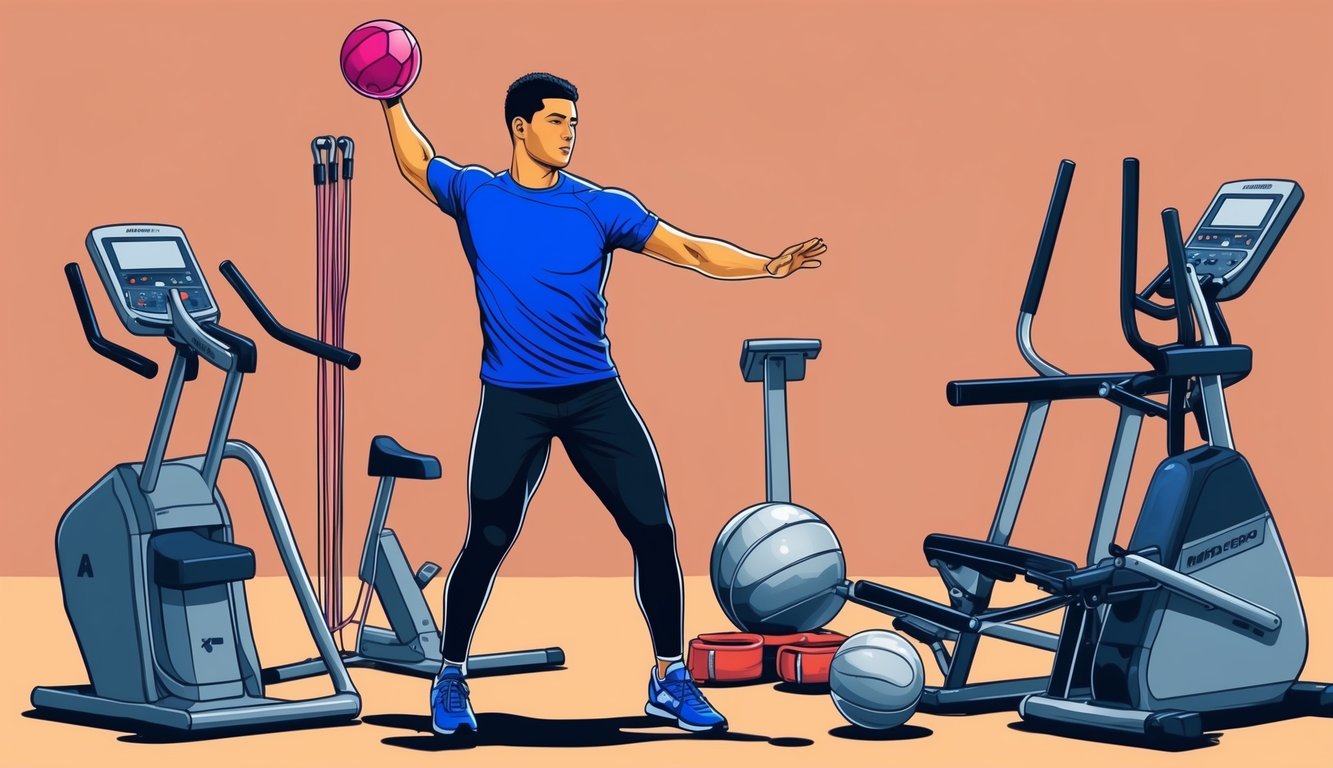
A balanced approach to cardio and recovery is essential for enhancing your Standing Power Throw performance.
Proper cardiovascular training boosts overall fitness while adequate rest enables your body to adapt and gain strength.
Cardiovascular Endurance and SPT
Adding cardio to your training plan can significantly benefit your Standing Power Throw (SPT) performance.
Aim for a combination of aerobic and anaerobic exercises to improve your cardiorespiratory endurance.
Utilize high-intensity interval training (HIIT) to elevate your anaerobic threshold, including sprint intervals or burpees.
Start with 30 seconds of maximum effort followed by 30 seconds of rest, repeating for 10-15 minutes.
For aerobic capacity, incorporate longer, steady-state cardio workouts.
Swimming, cycling, or rowing for 30-45 minutes at a moderate intensity can enhance your endurance without overly taxing your muscles.
Remember to progressively increase the intensity and duration of your cardio sessions to avoid overtraining.
Importance of Rest and Recovery
Rest is just as vital as training for improving your SPT performance.
Effective recovery allows your muscles to mend and strengthen post rigorous workouts.
Aim for 7-9 hours of nightly sleep to facilitate muscle recovery and hormone regulation.
Your body secretes growth hormone during deep sleep, essential for muscle repair and growth.
Pay attention to your body’s signals and take rest days when necessary.
Overtraining can lead to diminished performance, an increased risk of injury, and burnout.
Techniques for Effective Recovery
Implement these recovery techniques to enhance your SPT gains:
- Active recovery: Engage in light exercises such as walking or gentle stretching on rest days
- Foam rolling: Helps alleviate muscle soreness and improves flexibility
- Ice baths: May reduce inflammation and expedite recovery
Proper nutrition plays a crucial role in recovery.
Consume protein-rich meals within 30 minutes post-workout to aid muscle repair.
Maintain hydration throughout the day for optimal performance.
Consider utilizing compression garments to enhance blood flow and alleviate muscle soreness.
Massage therapy can also help relieve muscle tension and promote quicker recovery.
Measurement and Progress Tracking
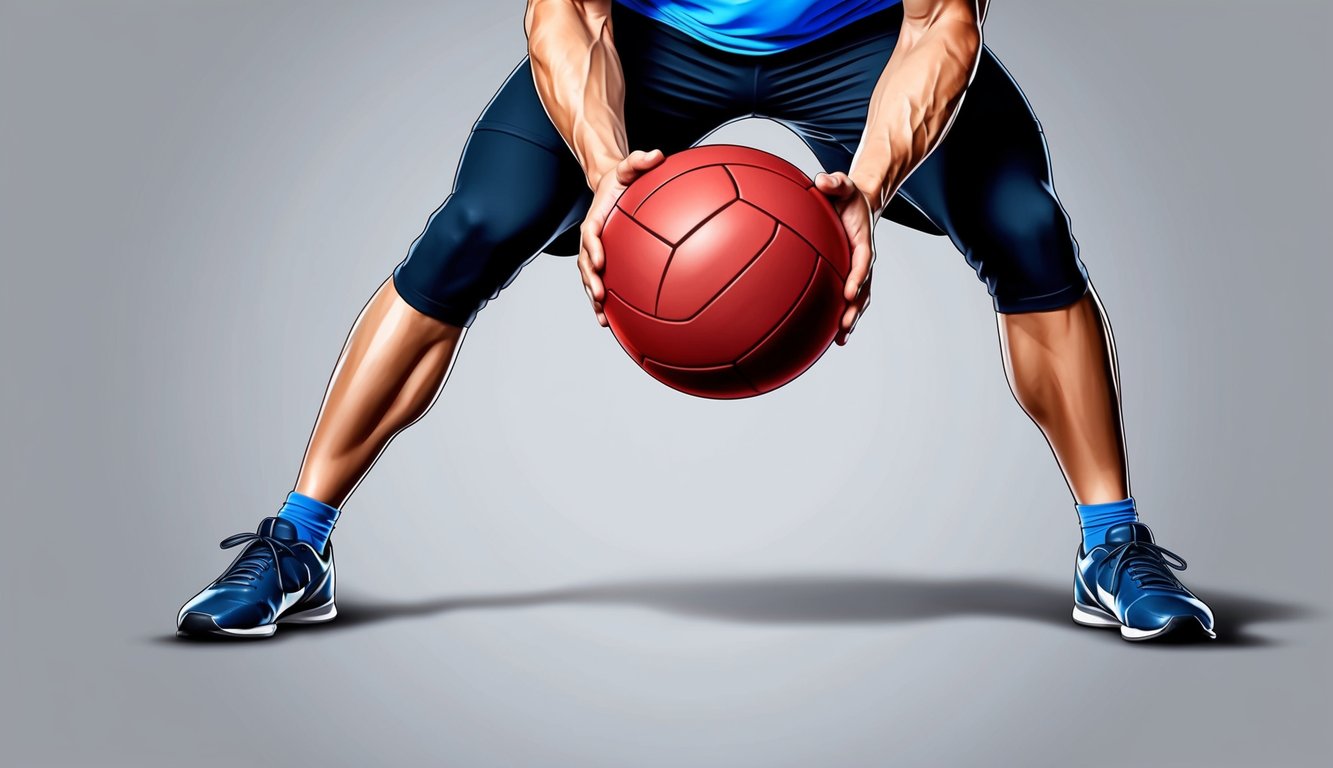
Monitoring your Standing Power Throw (SPT) performance is essential for continuous improvement.
Frequently evaluating your throws and setting targets will help keep you motivated and facilitate steady progress.
Assessing Your Initial SPT Performance
Begin by determining your baseline SPT performance.
Find a flat, open space and use a 10-pound medicine ball.
Clearly mark your starting position.
Execute three throws while adhering to the ACFT guidelines.
Measure the distance of each throw from the starting line to where the ball first contacts the ground.
Record your best score from the three attempts.
Pay attention to your form during these attempts.
Are you effectively utilizing your legs? How is your hip drive? Analyzing your technique will pinpoint areas that need improvement.
Setting Realistic and Achievable Goals
Using your initial evaluation as a reference, set specific and measurable goals.
If you’re new to the SPT, aim for a 5-10% increase in distance over 4-6 weeks.
Experienced throwers might aspire to more modest, incremental improvements.
Break down your primary goal into smaller milestones.
For example:
- Week 2: Improve hip drive
- Week 4: Boost throw distance by 3%
- Week 6: Achieve consistent form throughout all throws
Keep in mind that progress isn’t always linear; some weeks you may see significant advancements, while others may show minimal changes.
Regularly Monitoring Your Progress
Set a schedule for weekly or bi-weekly SPT practice sessions.
Perform three throws each time, replicating the ACFT format.
Document your distances and calculate your average throw.
Keep a detailed log of your performances, including:
- Date
- Best throw distance
- Average throw distance
- Notes on form and technique
Utilize a basic spreadsheet or a fitness app to visually track your progress.
This will help you identify trends and adjust your training plan as necessary.
Periodically reassess your goals.
As you improve, it may be necessary to establish new, more challenging targets to maintain motivation.
Age and Physical Considerations
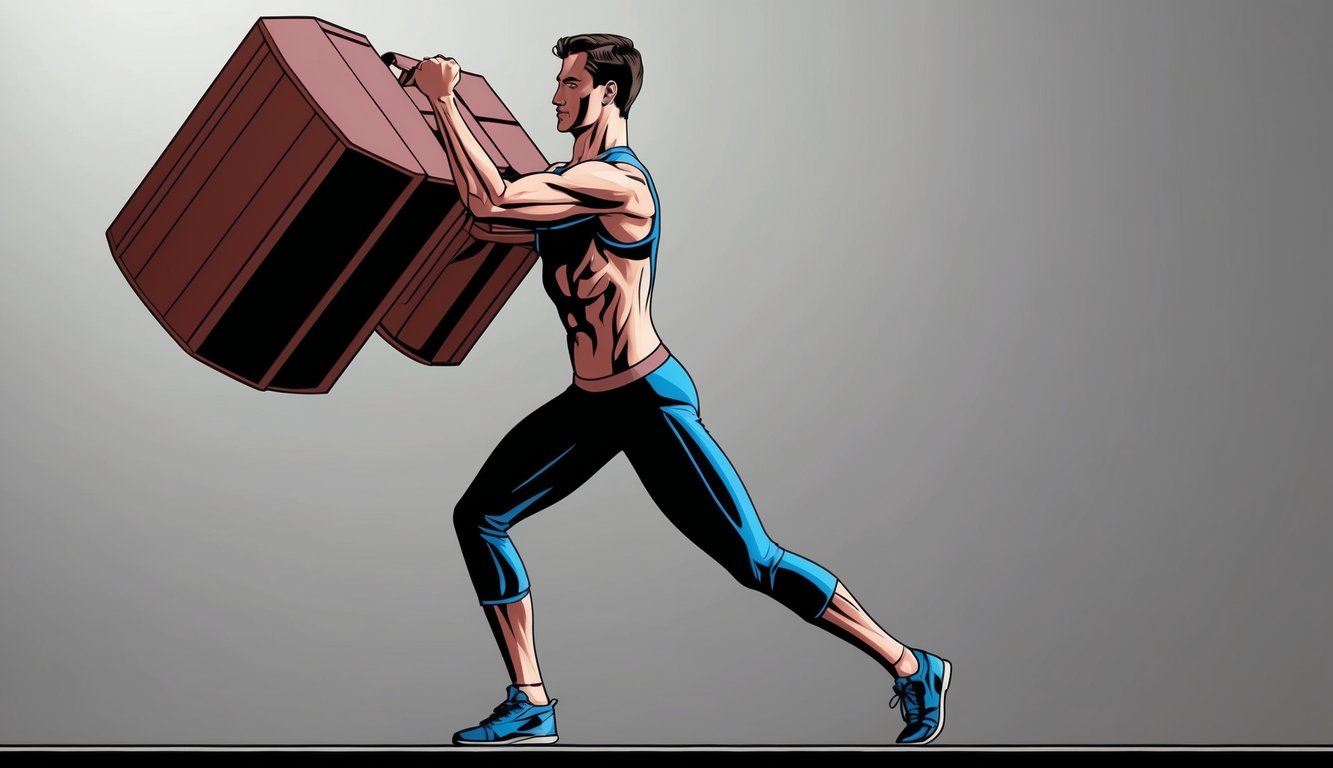
Your age and physical condition significantly affect your Standing Power Throw performance.
Customizing your training strategy and setting realistic goals based on these factors will help you maximize your potential and prevent injuries.
Training Adaptations by Age Group
For those under 30, prioritize explosive power development through plyometrics and Olympic lifts, as these can significantly improve throwing distance.
For individuals in their 30s and 40s, focus on maintaining power while emphasizing core strength and flexibility.
Incorporate medicine ball throws and rotational exercises into your regimen.
As you approach 50 and beyond, injury prevention should be your priority.
Balance power training with low-impact activities such as swimming or cycling, while also attending to mobility work, which is essential for maintaining a full range of motion in your throws.
Keep in mind that recovery time increases with age.
Listen to your body and adjust your training frequency accordingly, prioritizing quality over quantity.
Gender-Specific Considerations
Women typically exhibit less upper body strength than men, so focus on developing overall power.
Concentrate on lower body and core exercises such as squats, deadlifts, and planks to help generate more force from the ground up.
For men, while upper body strength may provide an advantage, do not overlook lower body power, as your legs and hips are vital for explosive throws.
Both genders should prioritize refining technique.
A well-executed throw can surpass mere strength.
Practice proper form with lighter weights before progressing to heavier loads.
Managing Expectations with Physical Limitations
If you have physical limitations, don’t let them discourage you.
Adapt your training to navigate around injuries or chronic conditions.
Focus on enhancing leg and core strength to compensate for any upper body issues.
Consult a physical therapist or trainer to create a safe and effective routine tailored to your needs, which may require exercise modifications.
Set achievable goals based on your current fitness level and limitations.
Track your progress over time rather than comparing yourself to others, and celebrate small improvements—they all contribute!
Consistency is crucial.
Regularly adapted training can lead to significant advancements, regardless of your starting point or physical constraints.
Frequently Asked Questions
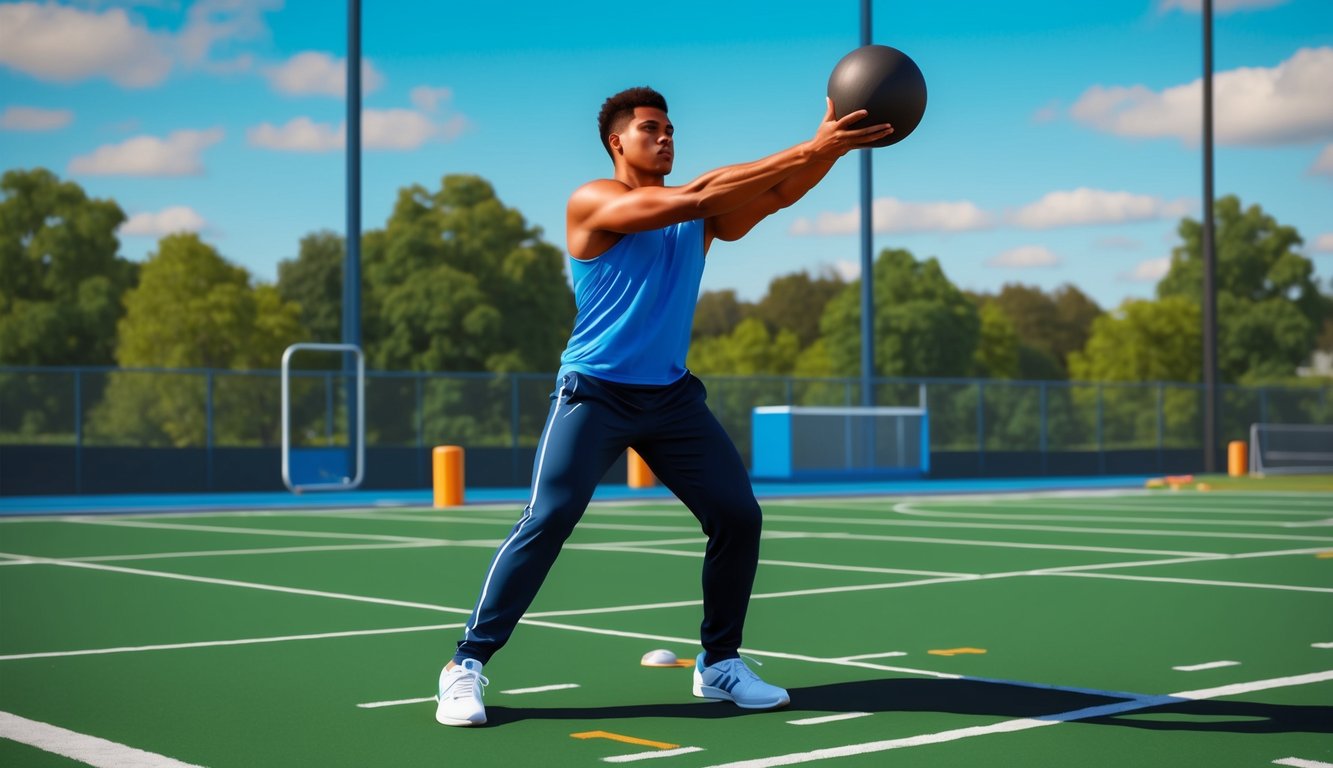
The Standing Power Throw necessitates specific techniques and training to enhance performance.
Here’s a response to some common questions regarding this event.
What exercises can help increase my strength for the Standing Power Throw?
Exercises like box jumps, plyometric push-ups, and medicine ball throws are excellent for enhancing your throwing power.
They specifically target the explosive strength required for the Standing Power Throw.
Which muscles should I focus on to improve my performance in the Standing Power Throw?
Concentrate on developing strength in your core, legs, shoulders, and arms.
Exercises such as squats, deadlifts, and overhead presses help strengthen these key muscle groups.
Are there any specific techniques to enhance the distance of the throw in the Standing Power Throw event?
Practice proper form by beginning with your feet shoulder-width apart.
Slightly bend your knees, then explosively push upward while releasing the ball.
Aim for a 45-degree angle to optimize distance.
How many practice attempts are typically allowed before the official Standing Power Throw assessment?
Typically, two practice throws are allowed before your official attempts.
Use these to warm up and get a feel for the movement.
What is considered a qualifying distance for the Standing Power Throw in the Army Combat Fitness Test (ACFT)?
Qualifying distances vary depending on your age and gender.
Check the latest ACFT standards to find the required distances for your specific category.
Where can I find a score chart to evaluate my progress in the Standing Power Throw?
Official ACFT score charts can be accessed on the U.S. Army website.
They are also available in ACFT preparation guides or through military fitness resources.

